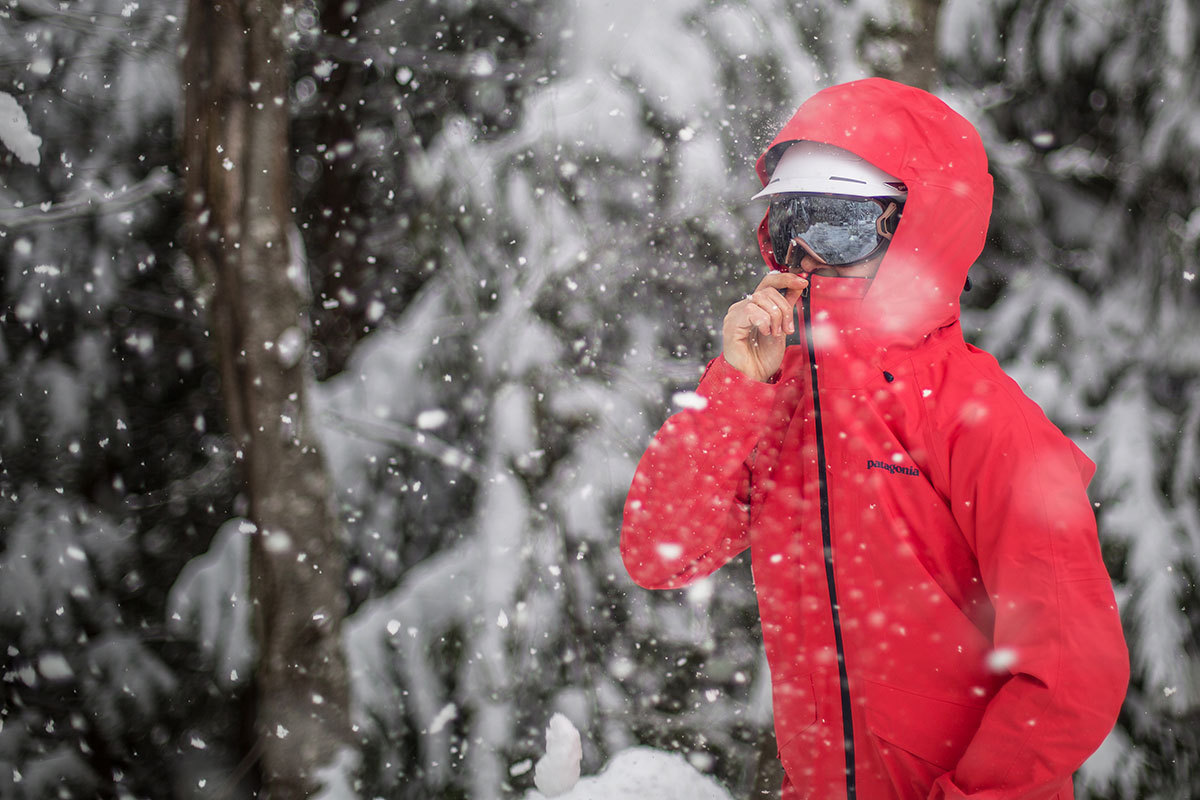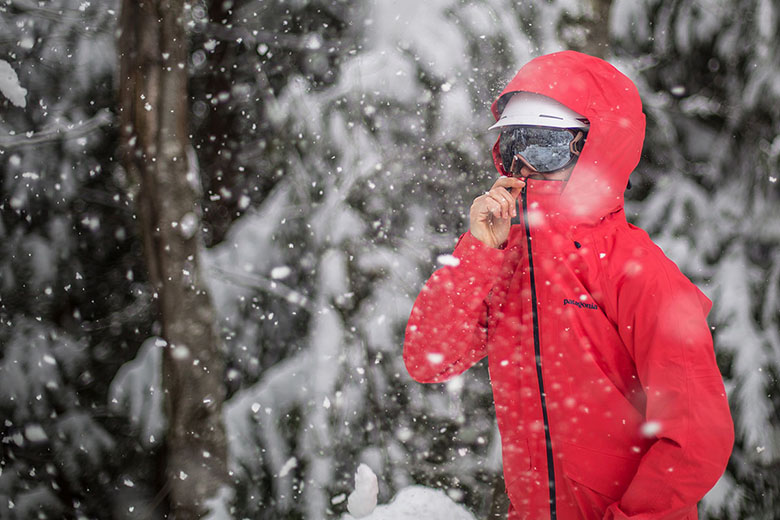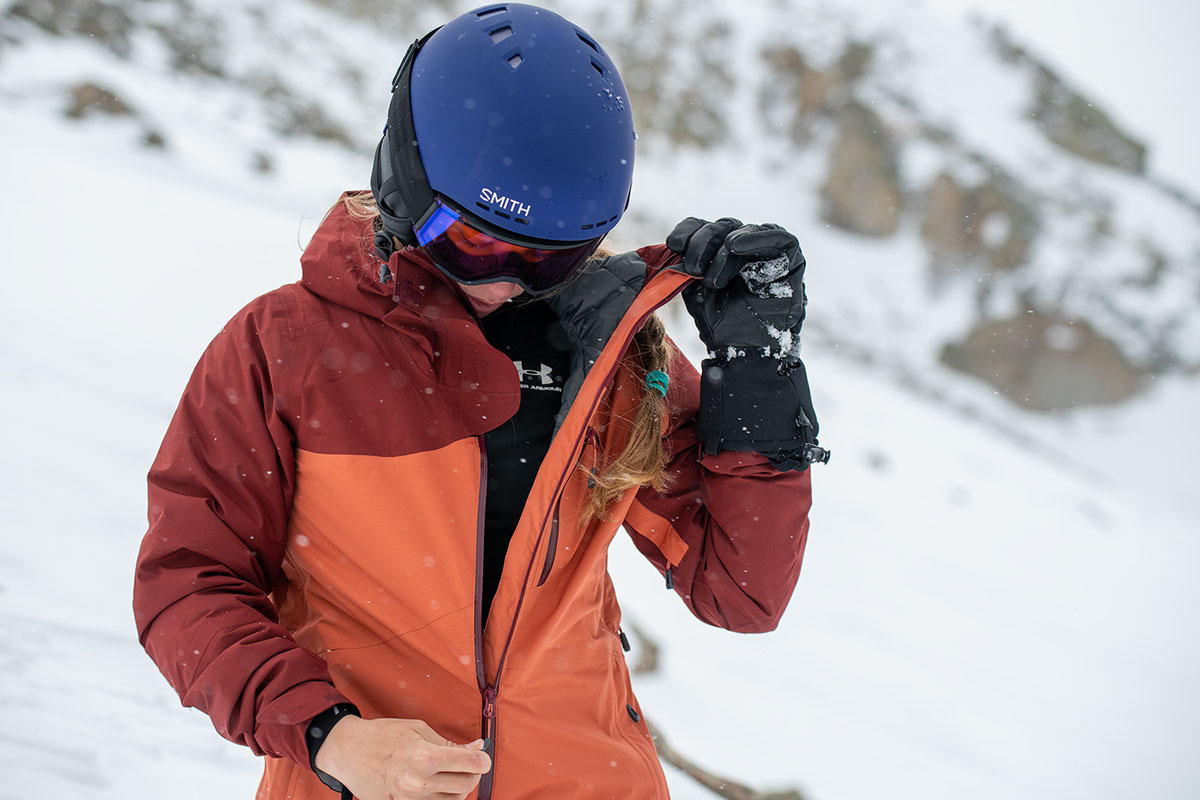

Price: $329
Waterproofing: 2-layer H2No Performance
Weight: 1 lb. 15.1 oz. (women's)
What we like: Everything we look for in a resort jacket at a reasonable price.
What we don't: Too warm and not breathable enough for high-output activities like touring.
See the Women's Patagonia Snowbelle See the Men's Patagonia Snowshot
Patagonia’s ski jacket lineup undoubtedly is impressive, from the fully featured PowSlayer hardshell to more basic resort options. Their Insulated Snowbelle Jacket falls on the latter end of the spectrum, and we gave it a full season of testing in British Columbia. The verdict: while its weight and lack of breathability put it squarely in the resort category, it’s a very protective and warm option for inbounds skiing. Below we break down our experience with the Snowbelle. To see how it stacks up to the competition, see our articles on the best ski jackets, best women's ski jackets, and best snowboard jackets.
Combining a sturdy 2-layer H2No Performance shell with a DWR (durable water repellent) finish, the Patagonia Insulated Snowbelle is highly effective at sealing out water. I put the jacket through some serious conditions, including a cold snap in Whistler (around -5 degrees Fahrenheit before wind chill) and quick rips up our local North Shore hill in typical freezing sleet and rain. During an especially brutal day with persistent sleet, the Snowbelle deftly kept out all moisture—no leaks or dampness made their way through the outer layer. For added protection, the large hood fits easily over my Smith ski helmets, the hand pockets feature substantial rain “hoods,” the powder skirt easily attaches to my Patagonia Powder Bowl snow pants, and the high collar covers most of my face when I’m slouching on a chairlift. I do wish the brim of the hood extended a bit farther to prevent water from dripping into my face—I luckily had a brimmed helmet—but this is a relatively small complaint..jpg)
Just as it performed well in rain and sleet, the Snowbelle withstands brutal winds extremely well. The peak of Whistler Blackcomb is notorious for its strong gusts, so much so that the chairlifts that service the resort’s alpine terrain often are closed. On a day when they were running, I hunkered into the jacket as we ascended and the exposure increased. Though my nose and cheeks grew cold quickly, no wind crept through the shell. The microfleece-lined collar was particularly helpful, although I wish it were an inch or two higher and rigid enough to stay up when the hood is down..jpg)
As Patagonia’s entry-level insulated ski jacket, the Snowbelle provides a good dose of warmth in moderate winter conditions. Like many other insulated designs, the Snowbelle uses more insulation in the body (80g of synthetic Thermogreen) than it does in the sleeves (40g). And during our testing, it was subjected to everything from arctic temperatures during a “Polar Vortex” to pelting snow and even bluebird days. It’s important to provide context here as insulated ski jackets are meant to provide a nice boost in warmth compared to their uninsulated counterparts, but they do have their limitations on frigid days. Sure enough, when temperatures dipped into the teens Fahrenheit, I had to begin adding layers underneath.
After a couple days of trial and error, I was able to nail the layering. In sum, the Snowbelle performs well in near-freezing temperatures at the resort (paired with just a light baselayer) but requires added layers when the mercury drops below that. For example, on one 10-degree day, I layered the jacket with a Patagonia Capilene Air baselayer and Nano-Air Light Hybrid Hoody and quickly grew cold on the chairlift. After a break in the warming hut and some sunshine, we began skiing more technical terrain that required additional exertion and I thawed out quickly. A few days later, the weather warmed up enough for me to unzip the main zipper while skiing (although I didn’t have to use the pit zips). All things considered, I recommend sizing appropriately so that you can adequately layer underneath depending on the conditions..jpg)
The Patagonia Snowbelle is designed with resort skiing in mind, and therefore breathability isn’t nearly as big of a concern as a more backcountry-focused jacket. Having said that, Patagonia’s in-house H2No waterproof membrane isn’t very breathable, but the Snowbelle does come with pit zips to dump heat quickly. Admittedly, I didn’t have the chance to test these pit zips as much as I would have liked—most of our ski days were too frigid—but I expect they’re just as well-executed as the rest of the jacket. Based on its design, I wouldn’t bring the Snowbelle into the backcountry or on any adventure where extensive hiking is required, but the jacket’s pit zips should offer enough ventilation for most resort days. If you plan to explore the sidecountry or simply run warm, an uninsulated hardshell jacket is a much safer bet, and you can always layer more underneath if you get cold..jpg)
If I had to choose what I love most about the Patagonia Insulated Snowbelle, it would be its next-to-skin comfort. First and foremost, the polyester taffeta lining is extremely smooth and supple and slides easily over any layer I choose. On warm days, I paired the jacket with only a merino t-shirt and remained completely comfortable. Further, the cozy fleece-lined collar and additional fleece panel along the back of the neck are nice touches for areas that experience a lot of friction. The same fleece also lines the hand pockets, which feels great on cold, dry hands. All in all, Patagonia build quality and materials win out here, and the Snowbelle is an extraordinarily cozy jacket.
The Patagonia Insulated Snowbelle has withstood everything I have thrown at it and is no worse for the wear. The jacket’s outer shell is a pretty robust 75-denier polyester, and the rest of the design from the smooth zippers to the well-constructed hood haven’t given me any issues. However, it’s important to point out that resort jackets like the Snowbelle aren’t held up to the same standard as my backcountry gear. That said, other resort-focused jackets I’ve tested have easily stained from rusty chairlifts, but the Snowbelle still looks like new..jpg)
At 1 pound 15.1 ounces, the Snowbelle clearly is a resort-focused jacket. Here, weight matters much less than it does in the backcountry, where ounces add up quickly as you haul gear up thousands of vertical feet. Compared to other insulated resort shells, the Snowbell is fairly average. Similar designs like the Flylow Sarah (1 lb. 11 oz.) and Patagonia’s own Insulated Powder Bowl (2 lbs. 0.5 oz.) clock in at similar weights, while 3-in-1 jackets, like the Snowbelle 3-in-1 (2 lbs. 8.7 oz.) come in heavier. If weight is a concern, you can save a lot with an uninsulated hardshell—to stick within the brand, Patagonia’s SnowDrifter clocks in at 1 pound 2 ounces. But for resort days, I was never overly concerned with the Snowbelle’s packability, nor did it feel heavy or excessively bulky.
Overall, I was very happy with the Snowbelle’s protective and full-coverage hood. To adjust, you simply pull the two drawcords at the base of the neck and one at the back of the head—it’s easy to snug both over a ski helmet. The hood also has a low-profile, laminated visor that holds its shape well. But although it seems substantial at around 2.5 inches, but doesn’t extend beyond the brim of my Smith Valence or Vantage ski helmets. While I appreciate that this doesn’t obstruct visibility, I wish that the visor extended just a bit more to better protect against falling snow and rain..jpg)
With a total of five pockets, the Patagonia Snowbelle has plenty of places to stow the essentials. The two fleece-lined handwarmer pockets are generously sized, and their zippers are angled diagonally to prevent items from falling out, even when unzipped. These pockets also contain pull cords to adjust the hem. The remaining outer pocket, a left chest pocket, contains cable routing for plugging into a phone and listening to music. On the inside, the Snowbelle features one internal zippered stash pocket with mesh lining (I usually stow my wallet here) and a drop-in pocket for goggles and gloves. I’ve even easily carried snacks and an extra merino long-sleeve baselayer in this large latter pocket. I do wish the Snowbelle had an additional arm pocket for storing a ski pass, but I was able to find room elsewhere..jpg)
I usually wear an extra small in Patagonia gear, but I opted for a small in the Snowbelle so that I had some wiggle room for layering underneath. Overall, I found the “regular” fit was great: the jacket never felt too roomy or loose, no matter which midlayers or baselayers I chose. On particularly cold days, I paired the Snowbelle with either a down jacket (my Feathered Friends Eos) or synthetic layer (my Patagonia Micro Puff Hoody or Nano-Air Light Hybrid Jacket), and each time I was comfortable and able to move freely. With only a thin baselayer underneath, the Snowbelle did feel loose but it was never overly bulky. Additionally, the sleeves are an ideal length and articulated for mobility, the Velcro wrist cuffs can be cinched down snugly to fit underneath my gloves (or loosened over gloves), and the hem length is great for my height (5’8”)—it covers my butt while standing but not while sitting.
Patagonia is well-known in the world of shells for their focus on sustainability, and the Insulated Snowbelle is no exception. First, the jacket uses a 70-percent-recycled face fabric and 90-percent-recycled insulation. Second, the lining is bluesign-approved, meaning it has been certified as being safe for workers, the environment, and consumers. And finally, the Snowbelle is Fair Trade Certified sewn, which indicates that Patagonia put extra money into making the jacket to ensure that workers have safe working conditions, adequate pay, and access to programs like healthcare and childcare services. Added up, these measures only boost the Snowbelle’s all-around appeal..jpg)
The Snowbelle lineup from Patagonia runs the gamut from the insulated jacket reviewed here, to snow pants, to a 3-in-1 resort option. To round out your kit, the Insulated Snowbelle Pants ($199) is a great option for the resort, with the same 2-layer H2No Performance fabric as the jacket and ample mobility for skiing inbounds terrain. If you prefer a 3-in-1 design, the 3-in-1 Snowbelle Jacket ($399) is a nice alternative to the insulated model: it uses the same H2No Performance construction and includes similar design features but adds in a 2.2-ounce zip-out polyester jacket. We prefer layering to buying a 3-in-1, but it truly comes down to personal preference and what you already have in your closet.
The Snowbelle tested here is a women’s jacket, and Patagonia makes a men’s-specific version called the Snowshot that also retails for $329. Compared to the Snowbelle, the Insulated Snowshot has the same amount of insulation (80g of Thermogreen), retains an identical feature set, and also uses a 75-denier, 2-layer H2No Performance build. However, the men’s Snowshot comes in slightly heavier at 2 pounds 0.5 ounces and is available in different colorways. The Snowshot lineup also is similar to the women’s, with both 3-in-1 and pant options available.
.jpg)
| Jacket | Price | Type | Best For | Waterproofing | Weight |
|---|---|---|---|---|---|
| Patagonia Insulated Snowbelle | $329 | Hardshell | Resort | 2-layer H2No Performance | 1 lb. 15.1 oz. |
| Patagonia Powder Bowl | $479 | Hardshell | Resort | 2-layer Gore-Tex | 2 lb. 0.5 oz. |
| Helly Hansen Alphelia | $475 | Hard/softshell | Resort | 2-layer Helly Tech | 2 lb. 3.3 oz. |
| Flylow Gear Sarah | $300 | Hard/softshell | Resort | 2-layer Intuitive | 1 lb. 11 oz. |
| Outdoor Research Tungsten | $399 | Hardshell | Resort | 2-layer Gore-Tex | 1 lb. 9.5 oz. |
| REI Co-op Powderbound | $199 | Hardshell | Resort | 2-layer Peak | 1 lb. 8.9 oz. |
From uninsulated hardshells to 3-in-1 options, there’s no shortage of resort-ready jackets. Within Patagonia’s lineup, the Insulated Powder Bowl Jacket features a more premium 2-layer Gore-Tex construction and a similar mix of 100g and 60g synthetic Thermogreen insulation (the Snowbelle uses 80g in the body and 40g in the sleeves). Compared to H2No, Gore-Tex is the ultimate in weather protection (the Powder Bowl’s thicker 150D shell also helps here), although the Powder Bowl comes in slightly heavier than the Snowbelle at 2 pounds 0.5 ounces. Otherwise, the two jackets have similar features: pit zips for dumping heat, ample organization, helmet-compatible hoods, and protective powder skirts. The Powder Bowl is a step up in warmth and quality, but at $479, it’s a major step up in price too..jpg)
Another premium but strong alternative is Helly Hansen’s Alphelia. Like the Snowbelle, the Alphelia is insulated (it uses Lifaloft synthetic) and boasts a full suite of resort-ready features, including a powder skirt (the Alphelia’s is detachable), helmet-compatible hood (also removable), ample storage, and a RECCO reflector. We also love the addition of four-way stretch, which boosts range of movement and comfort. Weight jumps to a hefty 2 pounds 3.3 ounces, and you do pay a premium at $475, but the Alphelia puts it all together better than most (the Snowbelle included) and is our favorite resort design this year.
Flylow Gear is another leader in the ski jacket market, and their competitor to the Snowbelle is the Sarah. For $29 less than the Patagonia, the Sarah offers similar warmth with 80-gram synthetic insulation, sports a functional feature set including a powder skirt, helmet-compatible hood, waterproof zippers, and hand gaiters, and boasts a stretchier shell that increases overall mobility. You do compromise a little in weather protection with Flylow’s 2-layer Intuitive build, but the Sarah nevertheless is a capable resort design for less than the Snowbelle (provided you don’t take it into truly rough conditions too frequently).
Outdoor Research recently released another competitive resort design in their Tungsten ski jacket. Rather than in-house waterproofing, OR opted for a more premium and protective 2-layer Gore-Tex build, which we found to be a great match for areas that see a lot of snow and wind. Further, the OR undercuts the Patagonia in weight at 1 pound 9.5 ounces and doesn’t skimp on features with pit zips, a powder skirt, a functional and helmet-friendly hood, and plenty of adjustability. Throughout testing, we found that the jacket ran noticeably warm even with the zippers open, and the hood was a little restrictive with the shell fully zipped (for more, see our in-depth Tungsten review here). But to be fair, these are pretty minor complaints for resort use, and the Tungsten gives the Snowbelle a run for its money across the board.
Last but not least is REI Co-op’s budget-friendly Powderbound Insulated Jacket. For only $199, the Powderbound boasts functional touches including a helmet-compatible hood, high collar, pit zips, and a powder skirt. You also get a good dose of warmth with 80-gram synthetic insulation around the core and 60-gram in the sleeves, and the REI undercuts the Snowbelle in weight at 1 pound 8.9 ounces. The biggest sacrifices you make are in protection and looks: the REI’s 2-layer nylon shell isn’t as weather-ready as Patagonia’s H2No membrane, and the Powderbound has a decidedly casual look to it. To be sure, the REI is a fine option for occasional resort-goers who don’t demand a lot of performance from their shell, but it’s a clear step down from the Snowbelle in overall quality.
If you’re thinking about buying gear that we’ve reviewed on Switchback Travel, you can help support us in the process. Just click on any of the seller links above, and if you make a purchase, we receive a small percentage of the transaction. The cost of the product is the same to you but this helps us continue to test and write about outdoor gear. Thanks and we appreciate your support!
Depending on the seller, most products ship free in the United States on orders of $50 or more. International shipping availability and rates vary by seller. The pricing information on this page is updated hourly but we are not responsible for inaccuracies.